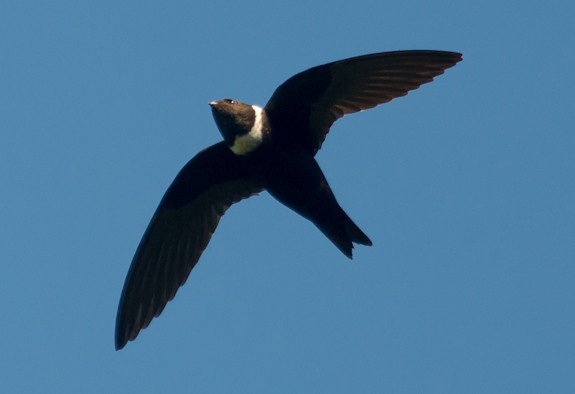White-collared Swift
A species of Collared Cypseloidine Swifts Scientific name : Streptoprocne zonaris Genus : Collared Cypseloidine Swifts
White-collared Swift, A species of Collared Cypseloidine Swifts
Botanical name: Streptoprocne zonaris
Genus: Collared Cypseloidine Swifts
Content
Description General Info
 Photo By https://www.flickr.com/photos/jquental , used under CC-BY-2.0 /Cropped and compressed from original
Photo By https://www.flickr.com/photos/jquental , used under CC-BY-2.0 /Cropped and compressed from original Description
The white-collared swift is a massive and powerful species, 20–22 cm (8–8.5 in) long, and weighing 90–125 g (3.2–4.4 oz). It is the largest species of swift in its range except in southwestern Mexico, where it may co-exist with its slightly larger cousin, the white-naped swift, which is one of the two largest swifts in the world. The white-collared swift has a wingspan of 45 to 55 cm (18 to 22 in). It has a very slightly forked tail, which often appears square. The adults are black, glossed blue on the back, and have a white collar, broader and duller on the breast than the hindneck. Young birds are duller than adults, and the collar is reduced or absent. 
Size
22 cm (8.75 in)
Nest Placement
Cliff
Feeding Habits
White-collared Swift, an insectivore, predominantly hunts flying insects in mid-air, including flying ants. It showcases aerial foraging techniques that capitalize on its swift flight. Unique adaptations allow it to feed while in flight, distinguishing its feeding behavior from many others.
Habitat
White-collared Swift predominantly resides in montane evergreen forests, but is also known to inhabit lowland evergreen forests, secondary growths, and scrub areas. This species typically forages in its preferred montane regions but can be found over various open habitats across broader neotropical regions. The adaptability of white-collared Swift to different environments highlights its resilience across diverse landscapes.
Dite type
Insectivorous
General Info
Feeding Habits
Bird food type
Behavior
This is a highly gregarious species, with flocks of 100 or more birds, and often in company with other swift species. It has a powerful, fast and direct flight, and will ascend thermals to great heights. White-collared swifts are known to attain or exceed flying speeds of 70 to 100 km/h (43 to 62 mph) despite their relatively large size. This noisy swift has a screeching chee-yar! call, which may be given in chorus by a flock. A flock will also make a "wooshing" sound as their wings beat against the wind. The white-collared swift feeds in flight on flying insects, including beetles, bees and flying ants. This species breeds in April to May, early in the wet season to correspond with a peak number of insect prey, building a cup nest out of mud, moss and regurgitated ground insect parts (the same matter that is later fed to the nestlings), each nest measuring 120–170 mm (4.7–6.7 in) in diameter with a depths of 30–90 mm (1.2–3.5 in). Nests are located on ledges and nooks along the cave walls. Two eggs are laid and the nesting stage ends when young become independent of their parents at 45–55 days. In Mexico, their only verified predators are Virginia opossums, which raid and eat the young in nests, and peregrine falcons, which are known to wait near colony entrances to pick off birds as they first fly off. 
Species Status
Not globally threatened.

 Photo By https://www.flickr.com/photos/jquental , used under CC-BY-2.0 /Cropped and compressed from original
Photo By https://www.flickr.com/photos/jquental , used under CC-BY-2.0 /Cropped and compressed from original Scientific Classification
Phylum
Chordates Class
Birds Order
Swifts and hummingbirds Family
Swifts Species
White-collared Swift